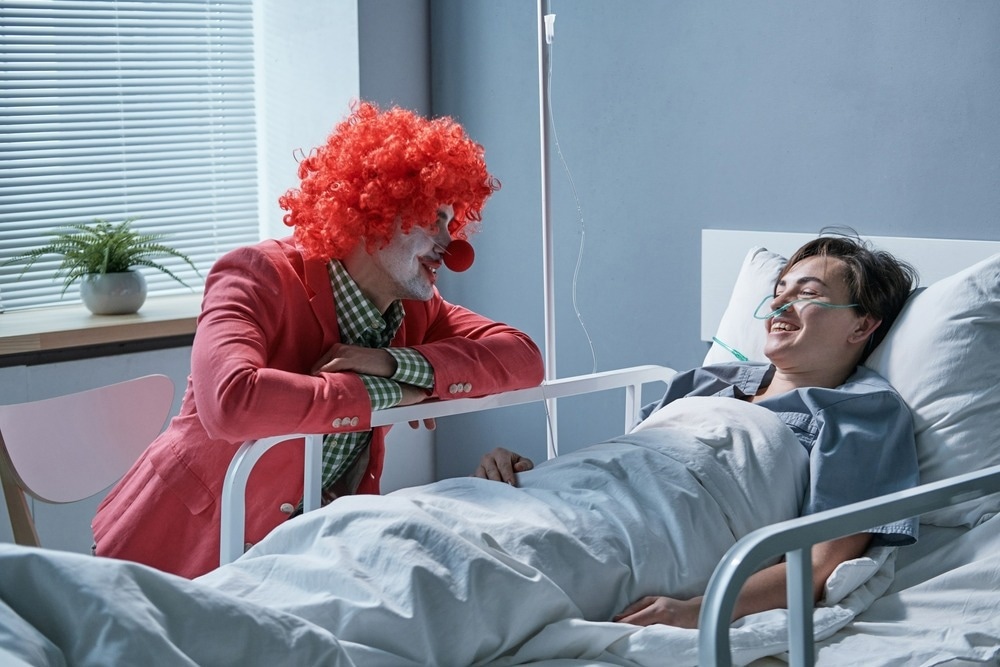In a recent study published in Scientific Reports, a group of researchers evaluated the impact of medical clown interventions on sleep quality and hospital stay duration in pediatric patients.
 Study: Medical clowns improve sleep and shorten hospitalization duration in hospitalized children. Image Credit: AnnaStills/Shutterstock.com
Study: Medical clowns improve sleep and shorten hospitalization duration in hospitalized children. Image Credit: AnnaStills/Shutterstock.com
Background
Sleep is crucial for recovery, yet hospital environments often disrupt it, particularly affecting pediatric patients. Hospitalized children experience late bedtimes, frequent awakenings, and reduced sleep time, intensifying their anxiety and discomfort.
Medical clowns, a non-pharmacologic intervention, have demonstrated potential in reducing stress and anxiety, enhancing overall well-being and cooperation in pediatric care, yet further research is essential to conclusively establish their effectiveness in improving sleep quality and overall recovery outcomes in hospitalized children.
About the study
This single-center, prospective observational study, conducted at The Lady Davis Carmel Medical Center in Israel from July 2019 to January 2022, involved pediatric patients aged 2-18 years, predicted to stay for at least two nights. Patients were recruited based on admission order and matched 1:1 for age and clinical condition with controls. Exclusions included children under 2 or over 18, those with sleep disorders, on sleep-altering medication, chronic conditions, a fear of clowns, or expected one-day hospitalizations. Participants were excluded if discharged or transferred within one night or if they removed the Actigraph sleep-monitoring device prematurely.
The study group received standard medical care and a session with a medical clown at bedtime, using relaxation techniques like music or guided imagination for 15–30 minutes. The control group, matched by medical condition, age, and if possible, gender, received standard care without clown intervention. Both groups wore Actigraph devices to measure sleep and were accompanied by a primary caregiver who completed a three-part questionnaire about the child's sleep at home, during hospitalization, and, for the clown group, the perceived effect of the clown on sleep.
Data from Actigraph devices were compared with parents' questionnaires, and each study participant's data was compared with their control group counterparts. An independent unpaired two-tailed t-test was used for statistical analysis, with a paired t-test for within-group comparisons across two hospital days. A p-value of less than 0.05 indicated statistical significance. Ethical approval was granted by the Carmel Medical Center IRB, with informed consent obtained from all participant caregivers.
Study results
In the present study, 57 children were initially recruited, but 15 were dropped for not completing the required two-night protocol, leaving 42 participants divided into a clown group (n = 21) and a control group (n = 21). Children were matched by age and clinical characteristics, averaging around 10.8 years, with a nearly equal gender distribution. Medical conditions varied, including acute appendicitis and abdominal pain, among others.
The sleep habits of both groups were initially similar. However, the study revealed significant differences in sleep patterns post-intervention. The clown group, exposed to a medical clown intervention before bedtime, showed a delayed wake-up time by approximately 27 minutes compared to the control group. This group also experienced longer time in bed and total sleep time as assessed by both objective measures and parental estimates.
Interestingly, the total wake time during the night was slightly shorter in the clown group. The mean sleeping period was longer in the clown group by 72 minutes, though this did not reach statistical significance. Sleep efficiency was marginally higher in the clown group. The mean number of awakenings during the night was lower in the clown group, but this also did not reach statistical significance.
A notable finding was within the clown group itself. When comparing the two nights for each child in this group, the night following the clown intervention showed a significant increase in total sleep time by 54 minutes, reduced total wake time, and improved sleep efficiency by 4.3%. These changes were mainly attributed to a reduction in the wake period after sleep onset.
Beyond sleep parameters, the study also observed general characteristics of the children's hospital stay. A remarkable outcome was that the length of hospitalization was significantly shorter in the clown group compared to the control group, with an average reduction of nearly a full day.
Conclusions
The study found significant improvements in sleep parameters for the clown group, including later wake-up times, reduced wakefulness during the night, and increased sleep efficiency. This improvement was particularly notable when comparing nights with and without the clown intervention within the same group. Moreover, the study discovered a substantial reduction in hospital stay duration for children who interacted with the clowns. These findings suggest that medical clowns not only improve sleep quality but also potentially expedite overall recovery.